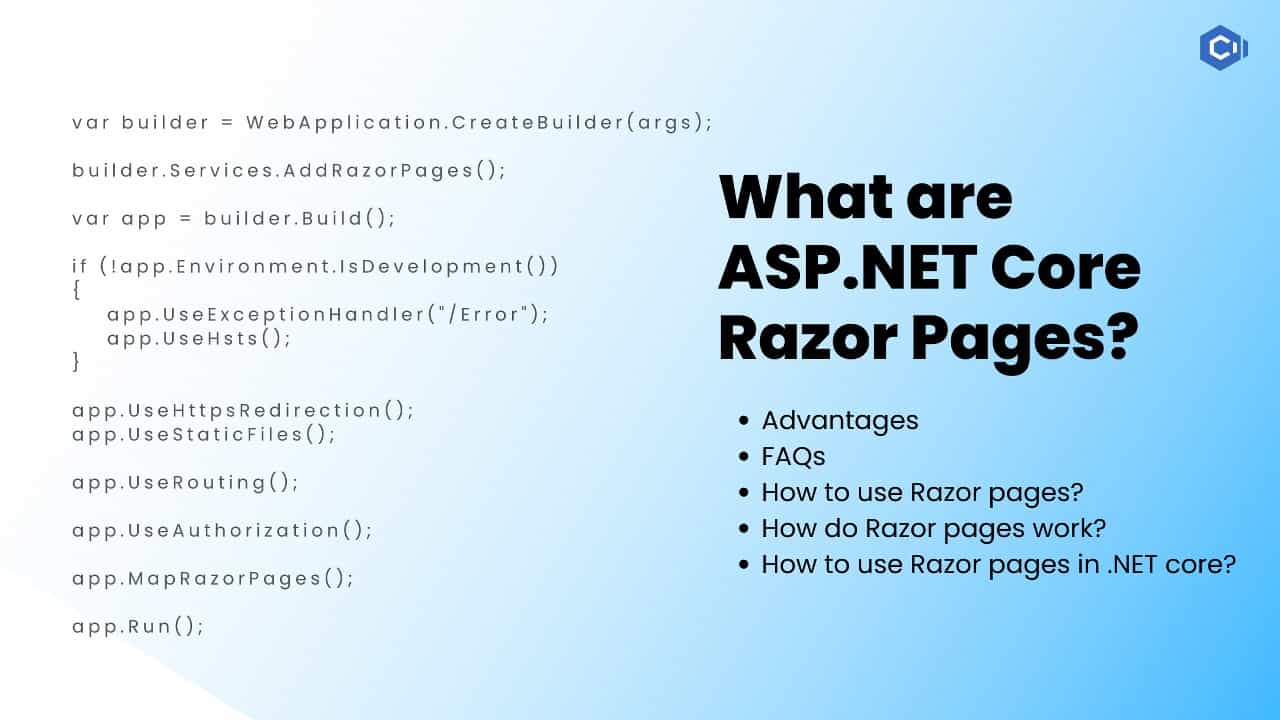“Razor pages” have become the buzzword in the web development community. It is a page-centric development model for building data-driven web pages in ASP.NET Core.
Due to better organization quality, Razor pages can group files by design and purpose to solve problems. ASP .NET MVC’s view component and Razor pages are very similar. The syntax and functionality of the Razor pages are similar to the MVC.

Does that mean there is no difference between Razor pages and ASP .NET MVC’s view component? No.
Razor pages have model and controller code included inside. It provides an easy development experience along with two-way data binding that seems similar to the MVVM framework, where model and view communicate directly.
Today, ASP .NET development services have become the most sought-after choice for web application development due to the benefits linked to it. Razor pages appear as the development of ASP .NET Web Forms that provide an MVVM solution.
???? You Must Also Read: How to Hire an ASP.NET Developer – Step-by-Step Guide
Advantages Of Using Razor Pages
Why are software developers interested in Razor Pages?
Here are some of the reasons that make Razor Pages interesting:
1. Any application using MVC can automatically include Razor Pages.
2. The context of the structure of Razor Pages remains simple.
3. Razor Pages has no controllers.
4. Developers choose it because of its flexibility to fit any type of application they wish to build.
5. Razor Pages feels organized as they have specific codes behind each page.
6. Like the web application built in ASP. NET web forms, it take less time to do the same in Razor Pages.
7. The coders get complete control over both URLs and HTML.
8. Having only one controller translates to fewer complications with better control.
9. Razor Pages allows you to check for any validation errors.
10. It helps manage any dependencies via dependency injection.
11. You can complete testing of Razor Pages using the IDE’s built-in test features.
FAQs About Razor Pages
What are ASP NET core Razor pages?
Razor pages refer to the latest aspect of the ASP .Net Core MVC. Developers became familiar with it after using ASP .Net Core 2.0. It is now included in .Net 5.
The Razor Pages has a flexible and lightweight framework that developers use for building a server-side application in ASP .Net Core.
The page-based approach of Razor Pages also provides full control to the developer. It can also work along with Web API controllers or conventional MVC.
If you have page-focused scenarios, Razor Pages may prove the best option. It is easy and productive compared to using views and controllers.
For cross-platform, HTML generation on the server side, the developer uses Razor Pages. Developers use the C# programming language for programming the server-side Razor Pages.
Razor templating syntax helps embed C# in HTML. The easy-to-learn Razor templating syntax aids in the dynamic generation of content for the browsers.
???? You Must Also Read: Top 11 .Net Development Companies
How to use Razor pages in .NET core?
To create an application in Razor Pages, you must at least have Visual Studio 2017. A version 15.3 or above can serve the purpose.
Your system must have a .Net Core SDK installed. To create a Razor Page application, you need to follow the steps suggested below:
♦ When you create a new project, you need to go to the Files and select Project from the New option.
♦ You need to choose .Net core from the left and ASP .NET Core Web application from the central panel when you choose the New Project window. Here you can provide the application’s name and its location. Click OK to save it.
♦ Next, you have to choose the template responsible for creating the Razor Page from the next window. You have to select the Web Application option from it while changing the authentication to read No Authentication. Click Ok.
♦ After you click OK, you can configure the Razor Page application within a few seconds.
These are the steps involved in using the Razor Page for your application.
What is a Razor Web page?
Razor refers to the markup syntax allowing coders to embed server-based code. You can add code of C# and Visual Basic to the web pages.
Using the server-based code, it becomes possible to build dynamic web content. While coders write the web page to the browser.
When you call the web page, the execution of server-based code present on the page occurs by the server.
After that, the page gets returned to the browser by the server. Due to running on the server, the code may complete complex tasks such as database access.
Razor pages have the same Razor syntax used in ASP .Net MVC. You can port several MVC-style applications to Razor Pages without a lot of modification to the views.
You must also modify link generation as it now uses page references instead of actions and controllers.
How do Razor pages work?
Instead of controllers and views used by the traditional ASP .Net MVC application, Razor Pages focuses on page-based scenarios while building web applications.
When the application gets an HTTP request, it reaches the middleware component after moving through the middleware pipeline where it gets handled and processed.
In short, it means routing middleware matching a URL path to a configured route.
The configured route can define invoking the specific Razor page for the request generated.
After the router selects the Razor Page, the final HTML response gets generated by the Razor Page after the framework execution.
The response generated goes to the client browser from where the request generates.
Like the View files in the ASP. Net MVC, the Razor Pages exists as a .cshtml file in the folder called Pages.
Each view has C# objects associated with it. You can call it the object Page Model. Page Model determines the page behavior.
Conclusion
Razor Pages has captured attention with its simplified model of web application programming.
It is the new concept eliminating the complications linked to ASP .Net MVC as it uses a file-based routing approach.





